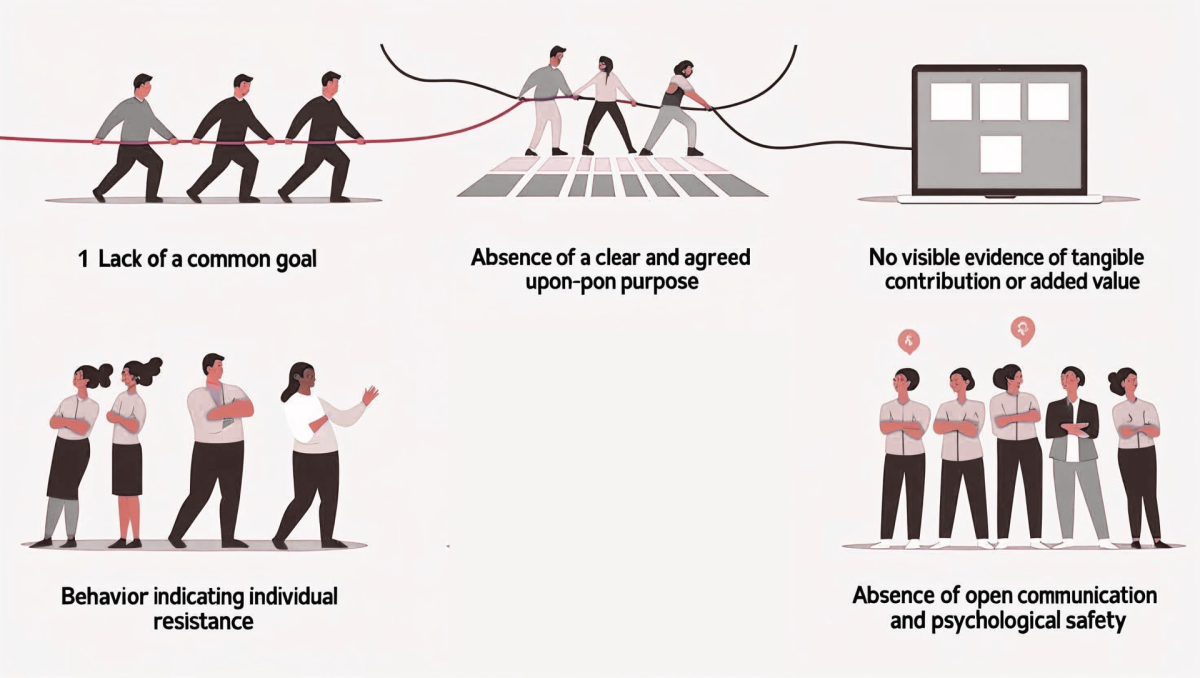Blog

The Five Missteps of Dysfunctional Teams
When teams fail it is for five very good reasons all of which are interrelated. The five most prominent missteps are these: lack of a common goal, absence of a clear and agreed upon purpose, no visible evidence of tangible individual contribution or added-value (skill sets, commitment, accountability), behavior indicating individual resistance (passive aggression or other disruptive behaviors), absence of open communication and psychological safety.
What follows are examples of situations that illustrate the impact of each of these missteps. The purpose is to enable teams to carry out a self-assessment of how their teams are doing and then finding better options for improving how their teams perform.
- Lack of a Common Goal:
-
-
- Example: A Marketing Team tasked with “increasing revenue.” Half the team interprets this as short-term sales promotions (discounts, flash sales), aggressively pursuing immediate conversions. The other half interprets it as long-term brand building (content marketing, community engagement), focusing on awareness and loyalty. They compete for budget, undermine each other’s campaigns (e.g., sales promotions devaluing the brand message), and blame each other for overall targets being missed. Resources are wasted, and the company’s market positioning becomes confused.
- Has your team ever forgotten that the competition is with the outside world and not an internal one that undermines the team and the company?
-
- Unclear Purpose:
-
-
- Example: A Software Development Team is told to “build a better customer portal.” Leadership provides no specifics on why it needs to be better, who the primary users are, or what specific problems it should solve. The team didn’t ask the why, what, who, when, where and how basics. Instead, the team builds features based on assumptions and personal preferences. The result is a portal overloaded with complex functions the average user doesn’t need, while missing critical, simple usability improvements. Users hate it, adoption plummets, and months of development effort are wasted. The team feels demoralized and directionless.
- What stood in the way of an open, two-way question and answer discussion to ensure a common understanding of the purpose? Was the company culture conducive to dialogue or did asking questions mean a lack of understanding or a challenge to leadership directives?
-
- Lack of Tangible Individual Contribution & Value (Skills, Commitment, Accountability):
-
-
- Example: A Cross-Functional Product Launch Team (Marketing, Engineering, Sales, Support) has vague role definitions. Key tasks like finalizing technical specs for sales materials and ensuring support team training fall through the cracks because “someone else” was assumed to be handling them. A brilliant engineer spends weeks optimizing a minor feature irrelevant to the launch, while crucial market readiness checks are neglected. When the launch fails due to unprepared support and inaccurate sales collateral, widespread finger-pointing occurs, but no individual accepts clear accountability for the specific failures. Contribution isn’t visible, and crucial skills aren’t utilized effectively.
- Has your team ever gone over budget and overtime in delivering its projects and how was the overtime and overspend assessed? Was blame or was problem solving used as the way out of the mess?
-
- Individual Resistance
- Hospital Process Improvement Team, a senior nurse resistant to new technology consistently engages in passive-aggressive behavior. They agree to test a new digital patient charting system in meetings but then subtly undermine it: “forgetting” their login, complaining loudly about minor glitches to colleagues during shifts (“See, this new system is useless!”), “accidentally” using old paper forms, and spreading skepticism (“This will just create more work for us”). Their influence sways other nurses, derailing adoption. Open discussion is stifled because team members fear confrontation with this influential but resistant member.
-
-
- Sometimes it is wise to apply surgical removal for toxic and inflexible members of a team who fear change because they see it as a risk of personal failure. It is easier to say goodbye to those unwilling to adapt than to undermine confidence and productivity of the entire team.
-
- Lack of Open Communication & Psychological Safety:
-
- Example: A Consulting Project Team working on a tight deadline for a demanding client has a leader who reacts defensively or dismissively to bad news or dissenting opinions. Team members quickly learn to:
- Hide potential problems or delays (“We’re fine, no issues!”).
- Withhold innovative but risky ideas for fear of criticism.
- Agree outwardly with the leader’s flawed plan while privately knowing it won’t work.
- Avoid admitting mistakes or knowledge gaps.
This leads to a major deliverable being fundamentally flawed because early warning signs weren’t raised, alternative solutions weren’t proposed, and a junior member who spotted a critical error was too afraid to speak up. The client rejects the work, damaging the firm’s reputation. Trust within the team evaporates. - Over and above all this the company lost the business of that client for good.
- Example: A Consulting Project Team working on a tight deadline for a demanding client has a leader who reacts defensively or dismissively to bad news or dissenting opinions. Team members quickly learn to:
Key Takeaway: These dysfunctions rarely occur in isolation. For instance, a lack of psychological safety (Challenge 5) often enables disruptive individual resistance (Challenge 4) to flourish unchecked. Resistance prevents the open communication needed to clarify purpose (Challenge 2) or define tangible contributions (Challenge 3), ultimately sabotaging the achievement of a common goal (Challenge 1).
Addressing these foundational challenges is critical for transforming dysfunction into high performance. These problems do not go away by themselves. It takes active leadership intervention, conflict resolution, fair mediation and a deep behavioral understanding of how teams work to rebuild healthy and high performing teams.

